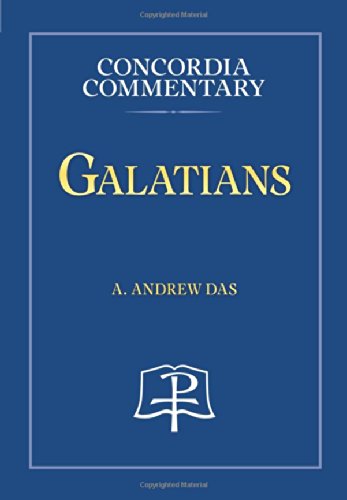 Galatians (Concordia Commentary), by A. Andrew Das (St. Louis, MO: Concordia, 2014), 808 pages.
Galatians (Concordia Commentary), by A. Andrew Das (St. Louis, MO: Concordia, 2014), 808 pages.
The purpose of the Concordia Commentary series is to serve “pastors, missionaries, and teachers of the Scriptures to convey God’s Word with greater clarity, understanding, and faithfulness to the divine intent of the text” (x). To that end, the convictions of the series are that Scripture is Trinitarian, Christ-centered, and Christological. The series focuses on expositions that are ecclesiological and sacramental. In short, these commentaries are confessionally Lutheran.
When I hear “confesionally Lutheran,” I think much of Lenski, who seemed often in his commentaries to interpret through his systematic theology rather than doing the rigorous historical work to interpret each text in its own terms. Whether that is a fair representation of Lenski or not, Das certainly falls on the opposite end of the spectrum. This commentary is full of references to extra-biblical Greek and Jewish literature throughout, as well as a thorough understanding and inclusion of the secondary literature available.
The introduction covers the standard issues of Galatians with delightful organization. These issues include mirror reading, the opponents, apocalypticism, North vs. South Galatia, Pauline chronology and the letter’s date, and Greco-Roman rhetoric and Galatian’s structure. Pastors and students will benefit tremendously from Das’s organization of the arguments, both for and against, in numbered lists, as in his discussion of the North vs. South Galatian issue.
In the commentary, Greek and Hebrew fonts are used, but transliterations are also given. While expanding the word count, this does provide a bit of relief to those such as myself who prefer seeing actual Greek and Hebrew fonts, while also accommodating the beginning student and pastors whose languages are not proficient enough to use regularly.
One other unique feature of this commentary series is that it uses images as codes for marking theological themes in the text, such as the Trinity, Passion, Atonement, Baptism, Lord’s Supper, etc. (xxxii-xxxiii). These images show up in the margins of the commentary. These may be helpful to a minister attuned to the necessity of highlighting these theological themes throughout, although I’m unclear of how helpful these images will be if the reader is already reading the commentary text.
Each passage includes a translation with textual notes following, which is then followed by a verse-by-verse commentary. These textual notes make the commentary more valuable because they discuss every textual variant in Galatians at some length. Also valuable are the excurses. For example, after a brief exegesis of 2:11-14 (the Antioch incident), Das includes an excursus on the issue at Antioch that deals especially with the New Perspective takes on the incident, to which Dunn initially brought so much attention and built his NPP on.
Those who receive the most attention in Das’s commentary are the usual suspects, including Dunn, Martyn, and de Boer. Das shows his clear understanding of these scholars’ positions on the NPP and apocalypticism, which is commendable. While treading through the murky waters of the various schools of thought, Das is able to emerge with his own unique Lutheran perspective on Paul and justification, which includes forensic justification (244-245) and freedom from the whole law, not just the boundary markers of Judaism.
The most difficult passages in Galatians, e.g. 2:11-22; 3:6-14; 4:21-32 are made to seem much simpler by Das. He writes lucidly with masterful organization of arguments and positions and clear conclusions. His skill is evident on both a macro level of the larger argument of Galatians as well as the detailed textual level of particles and conjunctions.
If you chose only one commentary on Galatians, choose this one. It is grounded in a Christological and ecclesiological view of Scripture, comprehensive in its coverage of historical backgrounds and secondary scholarship, clear in its conclusions, and fair in its treatment of alternative viewpoints. The result is a masterful and balanced commentary of most use to students and pastors, but also for scholars.
Find it here on Amazon.

